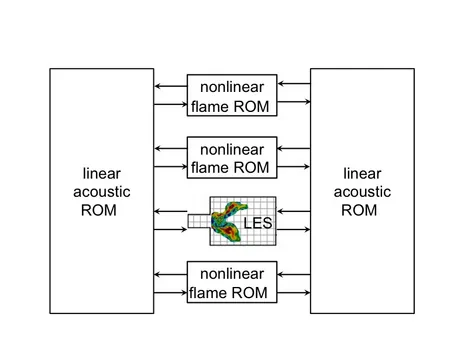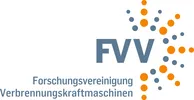Hybrid Reduced Order / LES Models of self-excited Combustion Instabilities in Multi-Burner Systems
Motivation
Thermo-acoustic combustion instabilities (TCI) are a major concern in the development of low-emission gas turbine combustors. These self-excited instabilities result from a constructive feedback between acoustic waves and an unsteady heat release rate and can lead to large pressure oscillations inside the combustion chamber. Depending on the finally reached limit-cycle (LC) amplitude of these oscillations, TCIs can lead to decreased efficiency, increased emission levels or even to the destruction of the combustor.
TCIs are a so called “multi-physics” and “multi-scale” problem involving various physical mechanisms and a large range of relevant time- and length-scales. Thus, modeling and predicting them remains a difficult task. In principal, high fidelity fully compressible 3D Large-Eddy-Simulations (LES) are able to capture all relevant mechanisms involved. But especially simulating large multi-burner systems that are employed in real gas turbines and aero-engines means tremendous computational effort. Therefore, this method is not suitable for the industrial development process of new combustion chambers.
A different approach combines a model for the flame dynamics, which is determined from LES or experiments, with Reduced-Order Models (ROM) for the acoustics. The advantage of this approach is its computational cheapness, which allows, for example, large parameter studies. But as the identification of accurate non-linear flame models is very difficult [1], this approach has its strength especially in linear stability analysis and not in the accurate prediction of LC amplitudes reached by TCIs.
Within this project, a hybrid approach is developed that combines the two methods mentioned above. This hybrid approach should preserve the accuracy of LES but at the same time reduce the computational cost significantly so that the new approach is suitable for the industrial development process.
Objectives and Strategy

Objective of this project is the development and validation of efficient methods for predicting thermo-acoustic LC oscillations in multi-burner configurations of real gas turbines and aero-engines. The new method is meant to extend the LES of one burner / combustion chamber to a full annular or multi-can combustion system. While just one burner is explicitly resolved by LES, the thermo-acoustic interaction with the remaining burners is imposed by boundary conditions. These boundary conditions are computed by ROMs of the acoustics and flame dynamics of the remaining burners. Fig. 1 shows a schematic of this approach for an exemplary system consisting of four individual combustion chambers coupled to each other on the up- and downstream.
Two different methods of coupling the ROM to the LES were developed and tested within the project Nonlinear Flame Dynamics. The first one couples a ROM via the characteristic variables to a fully compressible LES [2]. The second one employs a weakly compressible LES coupled to the ROM by the heat release rate and the inlet velocity fluctuation [3]. Both methods shall be used in the present project.
Since this approach is intended to predict thermo-acoustic LC oscillations, one key is the accurate modeling of the non-linear flame dynamics of the burners that are not resolved by LES. As stated above, identifying accurate and robust non-linear flame models is a difficult task. Thus, to increase the accuracy, the flame models will be adjusted “on the fly” to match the flame dynamics observed in the burner resolved by LES.
In a first step the proposed approach will be tested on a simple generic configuration. Due to the lack of experimental data on can- and annular combustors, the results will be validated by resolving the full configuration with LES. Subsequently, a transition to more complex and applied configurations takes place. As a final step the approach should validated with real gas turbine data.
[1] Jaensch, S., Polifke, W., 2017. Uncertainty encountered when modeling self-excited thermoacoustic oscillations with artificial neural networks. In Int. J. Spray Combust. Dyn. 9, 367–379.
[3] Jaensch, S., Sovardi, C., Polifke, W., 2016. On the Robust, Flexible and Consistent Implementation of Time Domain Impedance Boundary Conditions for Compressible Flow Simulations. Journal of Computational Physics 314, 145–159.
[2] Jaensch, S., Merk, M., Gopalakrishnan, E.A., Bomberg, S., Emmert, T., Sujith, R.I., Polifke, W., 2017. Hybrid CFD/Low-Order Modeling of Nonlinear Thermoacoustic Oscillations. Proceedings of the Combustion Institute 36, 3827–3834.
Acknowledgement

The financial support by the Research Association for Combustion Engines (Forschungsvereinigung Verbrennungskraftmaschinen e.V - FVV, project number: 6012700) is gratefully acknowledged.